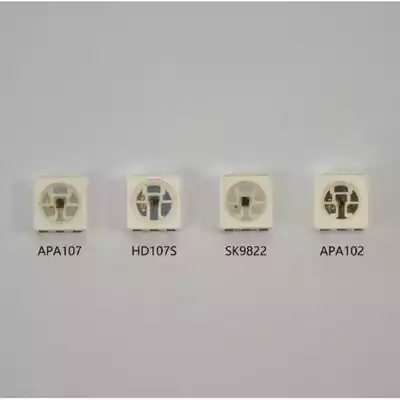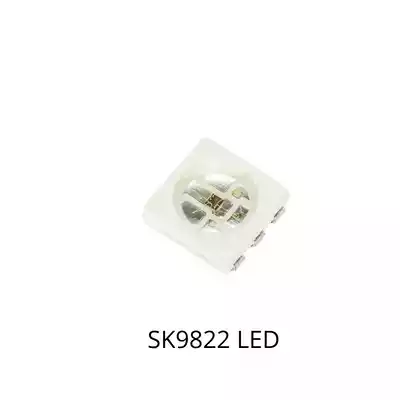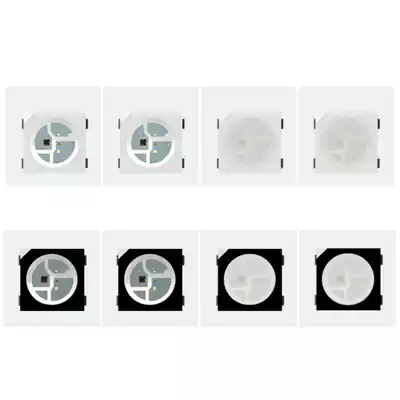What Different Of APA102,SK9822,HD107S,WS2812B, SK6812,WS2811,WS2815,WS2813
-
by Maisie Ou
- Last updated December 22, 2020
Table of Contents
LED strips are a great way to add some extra flair to your project, and do you know the differences between APA102, SK9822, HD107S, WS2812B, SK6812, and WS2811, WS2815, and WS2813? If not, don’t worry. This blog post will help clear things up for you. We’ll take a look at the specs of each LED strip to see how they differ. By the end of this post, you’ll be able to choose the best one for your project. Let’s get started!
Overview
APA102C are using SPI, and WS2812B their well-known proprietary protocol. There are more libraries for WS2812B than for APA102C and the WS2812B is better known in the community. The APA10C2 SPI protocol is faster, for example, if you want to build a video display device. Otherwise, I’d use the WS2812B as it is better to know and support.
ws2815 are the same as ws2812 but 12v which helps with powering them over longer runs plus they have an additional data line for redundancy so if one led dies the rest are not affected after it.
If you’re looking for a high-quality LED that can handle longer runs and provide redundancy in case of failure, the WS2815 is a great option. These LEDs are powered by 12v, which helps to prevent voltage drop over longer runs. Additionally, the WS2815 has an additional data line for redundancy, so if one LED fails, the others will continue to function properly. MSHLED offers a wide selection of WS2815 LEDs in a variety of colors, so you’re sure to find the perfect one for your needs. Check MSHLED WS2815 LED Strip in our product, You will find the feeling about the benefit of ws2815.
APA102C: 20+ kHz PWM. Internal LED chip
APA107: 9 kHz PWM.Internal LED chip
HD107s: 26+ kHz PWM (the upgrade of APA107).Internal LED chip
SK9822: 4.7 kHz PWM. Internal LED chip
WS2815: 2kHz PWM, Internal LED chip
WS2813: 2kHz PWM, Internal LED chip
Apa102c is the same as ws2812b, ws2811, just chip and output wire are different, APA102 Has data and clock, quality is stable too, whose PMW frequency Speed is much better than sk6812 and WS2812B, use big project it is better to use SK9822 and apa102, those who have data and clock, but those led chip, sometimes have a problem, one led is broken another will be affected, now WS2815 and WS2813 led to come out, which one led is broken.


APA102C VS APA102 VS APA107S
- APA107 RGB LED is a type ic for the three-color RGB Diming control strip and
string, This ic uses the CMOS process to provide three-color RGB LED output
driver to adjust the output with 256 grayscale and 32 brightness adjustment, APA
with 2 signal output ways, one is the clock, another is data, the clock and data is
synchronized, so that the crystal cascade piece of output movement is
Synchronized
- The APA102C comes in a package very similar to the WS2812, while the APA102 comes in a package with an increased metallization area to improve heat conduction.
- APA102: another SPI-based chipset, looks promising, packaging similar to the WS2812, but potentially much higher data rates.APA102 uses a standard two-wire SPI protocol – one clock line and one data line. Each LED has two inputs and two outputs which can be daisy-chained. At the first sight, this may seem wasteful, but it has the advantage of being supported by a standard microcontroller periphery and it is insensitive to timing variations. Due to the critical timing requirement, it is not possible to control the WS2812 from SOCs with multitasking operating systems, such as the Raspberry Pi. This should not be an issue with the APA102. Furthermore, the data can be transferred at an almost arbitrary clock rate. I was able to control the LEDs with a 4 MHz SPI clock without any hitch. APA102C does many items strip, check our APA102C LED Strip, you will find one type that is suitable for your project.
WS2812B vs WS2811 vs SK6812
WS2812B: The most well-known chip currently is the ws2812b chip. This chip became very famous partly because Adafruit gave it the name “Neopixels” and made it available to the general public a few years ago. They also did a lot of work in creating easy-to-use libraries for Arduino-based controllers. A big advantage of this LED chip compared to its predecessors is that this chip houses all the parts needed inside of the actual LED chip itself. Since their introduction, they have quickly become the most affordable LED chip and are readily available from lots of for cheaper prices than Adafruit tends to sell them. Quality-wise there isn’t too much of a difference between vendors since all LED strips and LEDs are manufactured by only a handful of manufacturers around the world. It is a 5V chip. MSHLED WS2812b LED Strip light is definitely a great choice for anyone looking for an affordable and good-quality LED strip.
WS2811:MSHLED WS2811 LED Strip light is a chip that was released before the ws2812b series. LED strips with this variant use an external chip that controls the connected LEDs. Most of these have been replaced by the ws2812b variant because it’s easier to integrate into a product but where size isn’t so much a limitation or another type of LED is desired then a surface mount one the ws2811 chip is still used. For instance, Christmas light style LEDs still often use the ws2811 because they use a different LED and the larger form factor of the chip isn’t a problem in that application. An advantage of the ws2811 is that it can also be used with 12v power (in certain configurations) but mindful though, sometimes those are only addressable per 3 pixels on the strip instead of 1! MSHLED WS2811 LED Strip light is great for those who want to save space and money.
SK6812: 5V LED Chip, a new competitor from the last 3 years or so. This chip is 100% compatible with the ws2812b and is basically a clone of it. It does however introduce interesting features such as RGBW support by adding an extra dedicated white LED for this inside of the package. Not all software supports this but if it does, it enables a whole new color pallet by mixing all the colors + white. This chip runs PWM at about 1.1kHz making it better in the regard to the ws2812b too.
WS2815 vs GS8208
WS2815: A new chip from the creators of the ws2812b and compatible with the same protocol. The main improvements are a higher internal PWM frequency (around 2kHz but some datasheets also state 8kHz), 12v compatible (5v logic signal), and dual signal wires so that if a chip gets damaged the signal should still reach all other chips. The downside of running 12v is that it often needs to “burn off” power depending on what is being displayed. This causes ws2815 to use more watts than a ws2812b running the same pattern. It is a 12V led chip. breakpoint transmission, this feature ensures that the rest of the LEDs in a strip still work even if one or more pixels develop a bad IC
GS8208:A new contender in the Digitally Addressable LED chip market. This chip is 12v compatible, has dual data lines for redundancy purposes, and a unique feature where if you do not provide a data signal it will start playing a test pattern on all the LEDs. It features a global 8kHz PWM frequency with constant current drivers per color making it a lot better flicker-wise than other strips. If you don’t send any data to the strip it will go into a test mode displaying various patterns, this stops once a data signal is detected. The data signal is ws2812b (clockless) compatible. It is a 12v chip. breakpoint transmission, this feature ensures that the rest of the LEDs in a strip still work even if one or more pixels develop a bad IC
Conclusion
To be more easily understood, you can see the detail of MSH WS2811 LED Strip Light, WS2815 LED Strip Light, WS2812B LED Strip Light and APA102C LED Strip Lighting.
If you are looking for a quality and reliable LED Strip Light, please do not hesitate to contact MSHLED. We offer a wide range of LED Strip Lights that are perfect for your needs. Our team is here to help you find the best LED Strip Lighting for your business or project. Don’t miss out on our great deals – contact us today!



